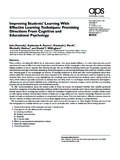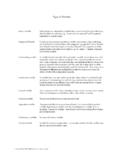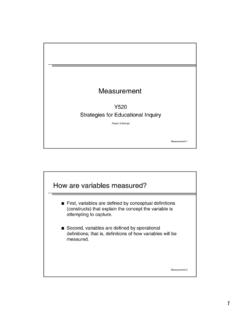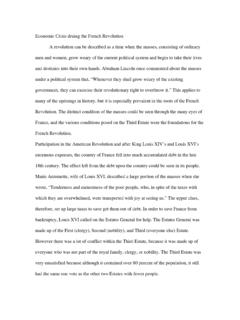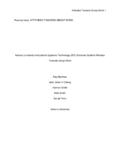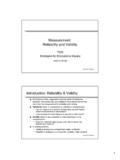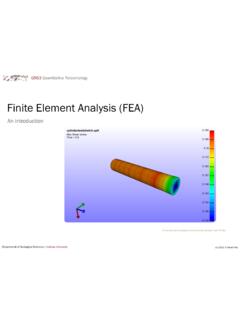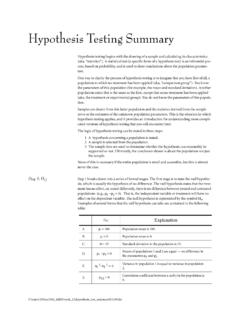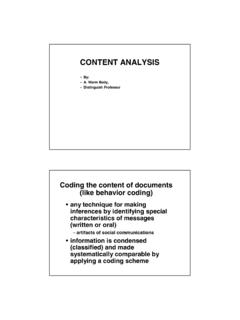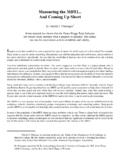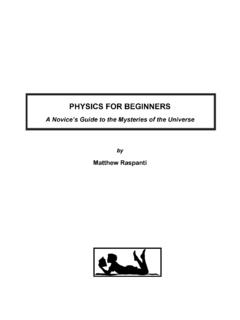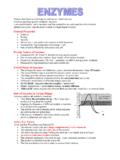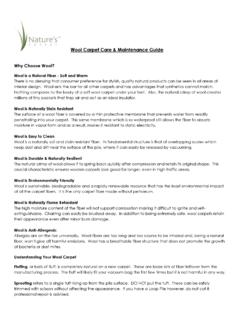Transcription of NATURE OF SCIENCE - INTRODUCTION Based on …
1 NATURE OF SCIENCE - INTRODUCTION Based on original prepared by Steven M. Dickhaus, Perry Meridian High School WHAT IS SCIENCE ? SCIENCE DEFINED: Concept: SCIENCE is limited to studying only the problems of the natural world that can be understood by using the processes of SCIENCE . Sub-concept: 1. Scientists deal with natural phenomena (events) which can be observed, measured, and tested by scientific methods; they must be able to use their senses to observe (directly and/or indirectly) and evaluate. 2. The processes of SCIENCE are very successful in dealing with problems within the limits of SCIENCE .
2 3. Scientific study is Based upon the assumption that the universe is orderly, reasonable, and testable. 4. A valid scientific theory offers a well-defined naturally occurring cause (mechanism) which explains why or how a natural event (phenomenon) occurs. 5. Scientific theories are always subject to change (tentative, uncertain). 6. SCIENCE does not have the answers to all of the questions in the universe, or the solutions to all human problems. HOW CAN WE TELL SCIENCE FROM NON- SCIENCE ? Concept: Following the discussion of "CONPTT", the student will be able to distinguish between scientific and non-scientific statements.
3 INTRODUCTION : To summarize our previous discussions and today's ideas, let's list some criteria that might help us recognize the difference between what is SCIENCE and what is not SCIENCE , criteria that will enable us to recognize a scientific statement and a non-scientific statement. The following criteria were developed by SCIENCE educators in Iowa and found acceptable by several midwestern high school biology teachers. SCIENCE IDENTIFICATION CRITERIA or THE CHARACTERISTICS OF SCIENCE Six Criteria of SCIENCE : Consistent, Observable, Natural, Predictable, Testable, and Tentative.
4 The sequence is not important, but the acronym "CONPTT" makes a good long term memory hook. 1. Consistency: The results of repeated observations and/or experiments concerning a naturally occurring event (phenomenon) are reasonably the same when performed and repeated by competent investigators. The event is also free from self-contradiction: it is consistent in its applications. The weight of the evidence is also compatible with well established observations and limits. REALITY CHECK #1: which of the following is a scientific statement, and which one is not a scientific statement?
5 1. Green plants will grow towards a light source. 2. Walking under a ladder will cause bad luck. Using the idea of "Consistency", how can we determine which statement above is a scientific one? 2. Observability: The event under study, or evidence of the occurrence of the event, can be observed and explained. The observations are limited to the basic human senses or to extensions of the senses by such things as electron microscopes, Geiger counters, etc. If the phenomenon cannot be reproduced through controlled conditions, natural evidence of the event's occurrence must be available for investigation.
6 REALITY CHECK #2: which of the following is a scientific statement, and which one is not a scientific statement? 1. Some plants eat meat. 2. Extraterrestrial beings have visited Earth. Using the idea of "Observability", how can we determine which statement above is a scientific one? 3. Natural: A natural cause (mechanism) must be used to explain why or how the naturally occurring event happens. Scientists may not use supernatural explanations as to why or how naturally occurring events happen because reference to the supernatural is outside of the realm of SCIENCE .
7 Scientists cannot conduct controlled experiments in which they have designed the intervention of a supreme being into the test. REALITY CHECK #3: which of the following is a scientific statement, and which one is not a scientific statement? 1. Green plants convert sunlight into energy. 2. With a rod, Moses parted the sea so his people could cross to the other Using the idea of "Natural", how can we determine which statement above is a scientific one? 4. Predictability: The natural cause (mechanism) of the naturally occurring event can be used to make specific predictions.
8 Each prediction can be tested to determine if the prediction is true of false. REALITY CHECK #4: which of the following is a scientific statement, and which one is not a scientific statement? 1. Without sunlight (or comparable artificial light), green plants will die. 2. If you are a "Scorpio", your horoscope for today is "You'll be saying 'I feel rich !' Lunar position highlights back pay, refunds, correction of accounting error." Using the idea of "Predictability", how can we determine which statement above is a scientific one? 5. Testability: The natural cause (mechanism) of the naturally occurring event must be testable through the processes of SCIENCE , controlled experimentation being only one of these.
9 Reference to supernatural events or causes are not relevant tests. REALITY CHECK #5: which of the following is a scientific statement, and which one is not a scientific statement? 1. The Bermuda Triangle causes ships and planes to sink and disappear. 2. Life comes from life and cannot come from non-life. Using the idea of "Testability", how can we determine which statement above is a scientific one? 6. Tentativeness: Scientific theories are subject to revision and correction, even to the point of the theory being proven wrong. Scientific theories have been modified and will continue to be modified to consistently explain observations of naturally occurring events.
10 REALITY CHECK #6: which of the following is a scientific statement, and which one is not a scientific statement? 1. The number of human chromosomes was once "known" to be 48, but is now considered to be 46. 2. Living things were once grouped into 2 major groups, then 3, then 4, and now 5, because the criteria used for classifying living things have changed. 3. We know that the world began about 6000 years ago, and nothing will change that. 4. At one time, it was thought the heart pumped blood out of a large container as an "open system", but now it is known that blood "circulates" in a closed system.
